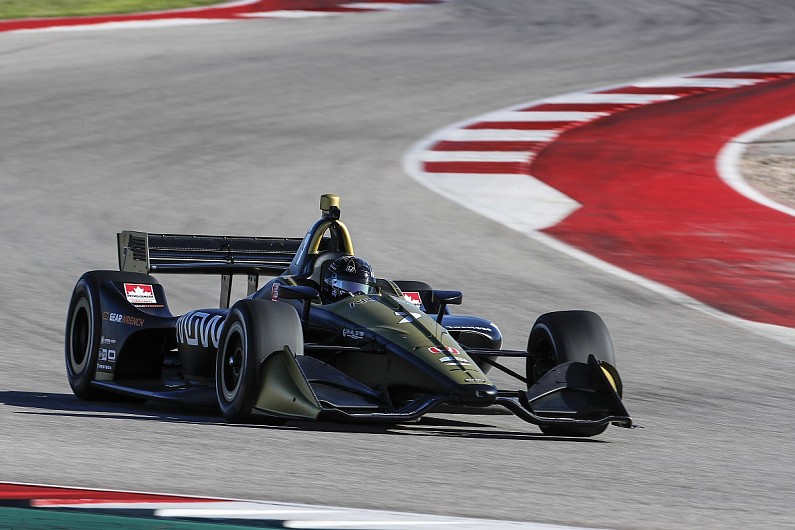Marcus Ericsson is preparing for his IndyCar debut this weekend after joining Schmidt Peterson Motorsports from the Sauber Formula 1 team. Here, he describes the main differences between the championships.
You’ve done five days in an IndyCar – or four-and-a-half days because of rain at Laguna Seca. Do you feel underprepared compared with your F1 debut?
No, no, the opposite. I think I only did half a day of running for [the] Caterham F1 team before my first grand prix! I was extremely underprepared for F1. So compared with that, I feel fine with IndyCar, quite honestly.
Any chance you get to test is valuable. But I’m experienced enough now to know what it takes to prepare for a new car, and I feel ready to get rolling.
You only ever raced in F1’s hybrid era. Have you got used to the fact that you no longer have that instant surge of acceleration, that you’re not being thrown backward by the thrust?
Actually, I would still say the main difference is the cornering itself, not the power. In Formula 1 there is so much grip, you can attack the corner so hard and be so aggressive in corner entries, and that doesn’t really work in IndyCar. You have to bring that back a bit and be more precise in the mid-corner to exit.
It’s still a fast car and it has a certain amount of downforce – it’s not like it’s a completely different car to drive. It’s more in the details.
A lot of drivers comment on the current Indycar’s natural tendency to understeer from apex to exit. Is that something it has in common with F1 or another thing you’ve had to adapt to?
I think what I’ve found is that in IndyCar, the balance is a bit more all over the place compared with Formula 1! You have to get used to that and work around it. Again, as a driver, you can help the situation by the way you brake and apply the throttle to make the balance better.
In Formula 1 it’s easier to dial out the balance issues and perfect it, whereas in IndyCar it’s more difficult to dial out those characteristics with mechanical changes in the pits. Instead you have to drive around it.
But that’s fine – that makes IndyCar more difficult to drive, more challenging for us drivers. It’s a different thing. OK, it’s maybe not so nice to drive, but if it’s more difficult, that is also good and brings satisfaction.
Although the brakes are weaker than in an F1 car, do you feel an Indycar reacts more to weight transference under heavy braking?
Yeah, that’s one of the things I found interesting – the way the IndyCar pitches. It’s very delicate the way you have to shape your braking, and the way you come off the brakes.
For me, it was a lot more challenging than a Formula 1 car because F1 has so much more grip in that phase. In an Indycar, you need to be a lot more precise in your technique with how you ease off the brakes and combine that with the turn-in. That’s been one of the ultimate learning processes for me – that it’s so critical in an IndyCar the way it pitches on the brakes.
Autosport says
David Malsher, Motorsport.com US editor
Ahead of this weekend’s IndyCar season opener in St Petersburg, David Malsher has analysed the prospects of IndyCar’s full-time teams – including Ericsson’s new squad SPM.
Schmidt Peterson Motorsports-Honda

#5 James Hinchcliffe
Starts: 122
Wins: 6
Pole positions: 1
Best championship position: 8th
#7 Marcus Ericsson
Rookie
Yes, the team is going to miss Robert Wickens’ presence in the cockpit this year, but Arrow Electronics’ large increase in investment in the team should still reap dividends.
As in 2018, the Sam Schmidt/Ric Peterson-owned team has the potential to be the most consistent thorn in the side of the ‘Big Three’ of Penske, Chip Ganassi Racing and Andretti Autosports – although the team’s ambitions reach still higher.
Hinchcliffe remains a strong and aggressive fighter on racedays, even if it sometimes takes him a while to find a set-up that both suits his driving style and allows him to manage his tires. When he’s in the zone, his confidence builds and then you just can’t count him out.

Ericsson, a veteran of almost 100 F1 races, has applied his very studious nature to the task of familiarising himself with IndyCars in a short time frame, and the Laguna Seca and COTA tests suggest that has paid off.
Whether he immediately has the confidence of a Wickens (or Hinchcliffe for that matter) and takes it to the edge in his first qualifying run or race, is more open to question, but that’s fine.
The best thing Ericsson can do is approach this new career chapter in whatever manner comes naturally, because Sam isn’t a big fan of drivers who are fast but crash frequently.
